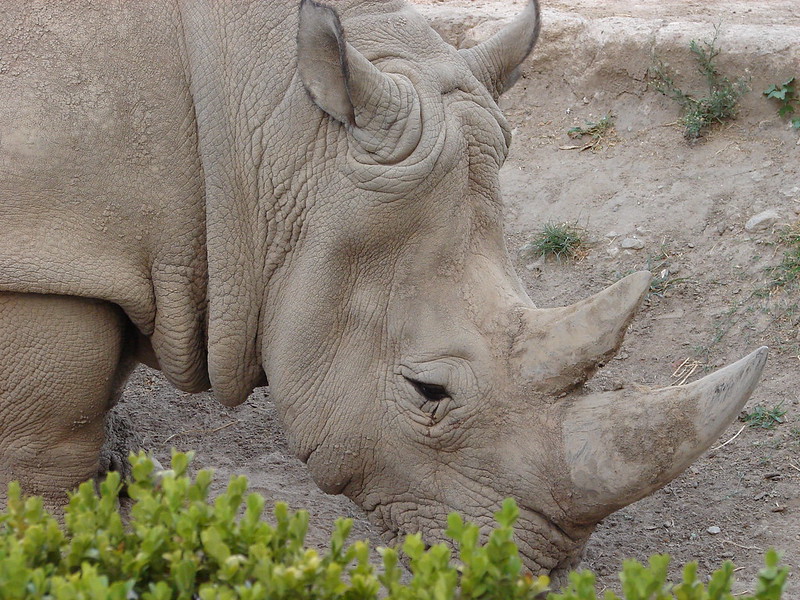Coronavirus, black swans, and grey rhinos
Two animal analogies to explain the emergence of COVID-19 and other «unexpected» disasters

All governments, from China to the United States to Spain and the rest of European countries (as well as the WHO, initially), have tried to justify themselves in the face of the terrible health – but also the economic and social impact – of COVID-19, the disease caused by a coronavirus. The justification was practically identical: no one had foreseen such a severe effect or such a rapid spread and, as a result, governments were not prepared to deal with it. Leaving aside whether this is credible after the spread of the disease in China, Iran, and Italy and, therefore, of the warnings that reached Europe about the impending disaster in a globalised world where distances no longer matter, perhaps it is worth reflecting on the devastating phenomena that threaten us without, allegedly, any warning of their appearance, consequences, and possible remedies.
Although the coronavirus is a microbe, I will use two animal analogies to explain the sudden and unexpected (or otherwise) appearance of phenomena such as COVID-19, but also other «unexpected» disasters of an economic, social, or political nature.
Black swans
Juvenal, a Roman poet who lived between the first and second centuries CE, wrote some famous Satires; in them he ironically described the life of Rome at the time. Some phrases from his poems have survived to the present day and are generally well known: mens sana in corpore sano, panem et circenses, quis custodiat ipsos custodes, rara avis, among others. This last one, more precisely, is part of a longer phrase, rara avis in terris nigroque simillima cycno, «a rare bird on earth, similar to a black swan». A black swan, two thousand years ago, was indeed a rara avis: only white, European swans were known; when, centuries later, black swans (indigenous to Australia) were discovered, it was too late to change the meaning of black swan, which is still interpreted today as something strange and unexpected, which happens in an unforeseen way and changes a long-established situation: a paradigm that was considered accepted, tested, and very well established is shaken and falls apart because of the appearance of the black swan.
There are plenty of examples, from epidemics to social and political revolutions, from unforeseen war victories (or defeats) to tsunamis, from the fall of meteorites to the baby boom, from Chernobyl to Fukushima, from Pearl Harbour to Vietnam. Later on, we will discuss whether these or other «black swans» were, in fact, as incidental and sudden as they seemed.
Nassim Nicholas Taleb, a Lebanese-American statistician and essayist, published Black Swan in 2007. In his book, Taleb outlined the characteristics of such an event: to begin with, a black swan is somewhat atypical, outside the realm of ordinary expectations; there is nothing in the past to indicate its possibility. Secondly, it has a great impact. And thirdly, despite this rarity, we invent post-factual explanations for its presence, so we end up considering it to be an explainable and predictable event. As Taleb himself summarised in an interview in The New York Times, it shares three characteristics: «rarity, extreme impact, and retrospective (though not prospective) predictability. A small number of Black Swans explain almost everything in our world, from the success of ideas and religions, to the dynamics of historical events, to elements of our own personal lives».
Thus, for some people (especially those responsible for combating it), the COVID-19 pandemic would be a black swan, something no one had foreseen. And I add, according to Taleb’s definition, that it is having a tremendous impact, which we cannot yet gauge but may change the world as we knew it; someone has said that «the pandemic caused by the coronavirus is not the end of the world, but it is the end of this world».
Taleb himself, and many others, disputes the idea that the current pandemic is a black swan. As he stated on television, it is a white swan if ever there was one. «We issued our warning that, effectively, you should kill it in the egg». Governments «did not want to spend pennies in January [2020]; now they are going to spend trillions».

There are different rhinoceros species, but the best known (and most endangered) are the black and the white African rhinos – those are not their real colours: their armoured skin has a darker greyish tone, in the case of black rhinos, or a lighter one, in the case of white rhinos. The grey rhinoceros of the analogy are a mixture of both. / Guerretto, en Flickr
Grey rhinos
And here is the other animal analogy: the grey rhinoceros. There are different rhinoceros species, but the best known (and most endangered) are the black and the white African rhinos – those are not their real colours: their armoured skin has a darker greyish tone, in the case of black rhinos, or a lighter one, in the case of white rhinos. The grey rhinoceros of the analogy is a mixture of both, and has the characteristics of both species. For example, imagine you are in the vehicle of an African safari: you see one in the distance, but it suddenly rushes towards the vehicle; you know that it is a very dangerous animal and hence poses a very probable and serious threat… but you do not listen, because you think your vehicle will resist a potential charge from this irritable pachyderm. When it finally hits and destroys the vehicle, seriously injuring you in the process, you realise that you may have been reckless, that the warnings and dangers signs were there, but you failed to follow them.
Michele Wucker, who works as a political analyst, wrote an entire book on grey rhinos (Wucker, 2016) and distinguishes four categories. Charginf rhinos: problems that arise suddenly and have to be tackled quickly; we need to know how fast they move and what damage they can do. Recurring rhinos: problems that have already happened before so we have some experience that can be used to deal with the current episode (financial crises, flu epidemics, etc.). Meta-rhinos, the most dangerous; they are those structural factors that prevent us from dealing adequately with problems; Wucker blames business management, that is, corporate policy, because it is rigid and impervious to change: it is business as usual. Finally, there are unidentified rhinos, those that do not let us see what the problem really is; she points out to the changes that artificial intelligence will bring about in many areas, which we can expect but which are very uncertain (Yuval N. Harari, 2016, 2018, for example, identified some of these social and economic changes, but they might not be the ones to occur). What is clear is that, in the face of any kind of grey rhino, the worst possible option is doing nothing.
No room for distraction
All this digression and, especially, the above-mentioned essays, among many others that we could cite and which have proliferated in recent times, lead us to an inescapable conclusion: catastrophic events can be foreseen (in fact, someone predicted them some time ago); we are not prepared to deal with them because of indifference (either by the government or by academic experts, who prefer to speculate about certain things) or because of pettiness; when they finally strike us, we focus on the usual mechanisms, weapons, protocols, etc., which, by all accounts, do not work because they were prepared for other types of events. And, of course, we cover our backs saying that an event was a black swan, when in reality it was a grey rhinoceros, which had been around for a long time and had threatened us, but we had wilfully ignored it (Sheng, 2017; Baram, 2020).
If we have to look for solutions to these catastrophic events that after-the-fact crisis cabinets can hardly deal with, they must come from taking advantage of the knowledge of think tanks focusing on prospecting. In all areas, from science to humanities, from social sciences to technology, there are experts who are dedicated to considering future scenarios and potential approaches with guarantees of success. Lately, artificial intelligence has come to help these experts’ natural intelligence, and it is difficult to find a complex economic, social, technical, or health scenario that has not been foreseen and for which no plan has been designed, either to solve it, to adapt to it, to prevent it from occurring, or to flip it and take advantage of it.
The problem is that these attempts to deconstruct future, but predictable, problems (which, I insist, include all of them: there are no black swans, only grey rhinos), do not usually come from university and academic seminars. In some cases (Harari, 2016, 2018; Rees, 2019, etc.), authors publish widely distributed books illustrating these possible futures. Do politicians take them into account?
Politicians from across the board could learn something, but they are often allergic to discussing scenarios and adopting strategies that go beyond the four years that they will be in office. If only a few of them have permanent scientific advisors, how do you expect them to have any interest in listening to what expert groups can tell them about the vast array of issues that politicians will have to legislate on? These comments apply to all kinds of governments, all over the world.
These days there is still a debate about whether scientists should dictate policy (health policy, in this case, related to the coronavirus pandemic) or whether they should limit themselves to offering advice and politicians should be the ones who, properly trained, pass laws and organise the logistics to solve this and other science-based problems. My many years of experience as an advisor to politicians on environmental issues in Spain and abroad has taught me that this dilemma is missing a point.
I firmly believe that elected officials, conveniently informed by experts, must be the ones to make policy (and, of course, they must be accountable to society); but first, politicians need to understand what the experts are telling them; secondly, these experts must be known to the general public and especially to the scientific community, which is best placed to judge whether the government’s advisors are sound scientists or not; in relation to the COVID-19 pandemic, the scientific advisors to the Catalan, Spanish, and French governments, to quote but a few close examples, would need to pass the scrutiny of the international scientific community.
And, thirdly, politicians should take careful account of expert scientific advice, in addition, of course, to non-scientific advice (labour, economic, social, etc.), which should also be considered. And they should act considering all the expert opinions. But I am afraid that this type of politician is also rara avis.
References
Baram, M. (2020). Why the coronavirus crisis is a "gray rhino" and not a "black swan". Fast Company, 10 March. https://www.fastcompany.com/90475793/why-the-coronavirus-crisis-is-a-gray-rhino-and-not-a-black-swan
Harari, Y. N. (2016). Homo Deus. Breve historia del mañana. Barcelona: Debate. Penguin Random House.
Harari, Y. N. (2018). 21 lecciones para el siglo XXI. Barcelona: Debate. Penguin Random House.
Rees, M. (2019). En el futuro. Perspectivas para la humanidad. Barcelona: Crítica.
Sheng, A. (2017). From black swans to grey rhinos. The Star, 22 July.
Taleb, N. N. (2007). The Black Swan. The Impact of the Highly Improbable. New York: Random House.
Wucker, M. (2016). The Gray Rhino: How to Recognise and Act on the Obvious Dangers We Ignore. New York: St Martin Press.





